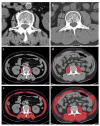Radiologic Definition of Sarcopenia in Chronic Liver Disease
- PMID: 33504046
- PMCID: PMC7910987
- DOI: 10.3390/life11020086
Radiologic Definition of Sarcopenia in Chronic Liver Disease
Abstract
Sarcopenia is prevalent in patients with chronic liver disease, and affected patients tend to have worse clinical outcomes and higher mortality. However, relevant analyses are limited by heterogeneity in the definition of sarcopenia and in the methodological approaches in assessing it. We reviewed several radiologic methods for sarcopenia in patients with chronic liver disease. Dual energy X-ray absorptiometry (DXA) can measure muscle mass, but it is difficult to evaluate muscle quality using this technique. Computed tomography, known as the gold standard for diagnosing sarcopenia, enables the objective measurement of muscle quantity and quality. The third lumbar skeletal muscle index (L3 SMI) more accurately predicted the mortality of subjects than the psoas muscle index (PMI). Few studies have evaluated the sarcopenia of chronic liver disease using ultrasonography and magnetic resonance imaging, and more studies are needed. Unification of the measurement method and cut-off value would facilitate a more systematic and universal prognosis evaluation in patients with chronic liver disease.
Keywords: CT; DXA; MRI; chronic liver disease; radiologic evaluation; sarcopenia; ultrasonography.
Conflict of interest statement
We declare that we have no financial and personal relationships with other people or organizations that can inappropriately influence our work, and there is no professional or other personal interest of any nature or kind in any product, service, and/or company.
Figures




Similar articles
-
Assessment of muscle mass using chest computed tomography-based quantitative and qualitative measurements in patients with systemic sclerosis: A retrospective study with cross-sectional and longitudinal analyses.Semin Arthritis Rheum. 2023 Apr;59:152168. doi: 10.1016/j.semarthrit.2023.152168. Epub 2023 Jan 19. Semin Arthritis Rheum. 2023. PMID: 36736023
-
Low muscle mass determined by psoas muscle area does not correlate with dual-energy x-ray absorptiometry or total lumbar muscle mass scores: A prospective cohort study of patients undergoing vascular surgery.Vascular. 2023 Feb;31(1):107-114. doi: 10.1177/17085381211059404. Epub 2022 Feb 1. Vascular. 2023. PMID: 35104187
-
Cut-off values of skeletal muscle index and psoas muscle index at L3 vertebra level by computerized tomography to assess low muscle mass.Clin Nutr. 2021 Jun;40(6):4360-4365. doi: 10.1016/j.clnu.2021.01.010. Epub 2021 Jan 16. Clin Nutr. 2021. PMID: 33516603
-
Sarcopenia and chronic liver diseases.Expert Rev Gastroenterol Hepatol. 2018 Dec;12(12):1229-1244. doi: 10.1080/17474124.2018.1534586. Epub 2018 Oct 16. Expert Rev Gastroenterol Hepatol. 2018. PMID: 30791794 Review.
-
Imaging of sarcopenia: old evidence and new insights.Eur Radiol. 2020 Apr;30(4):2199-2208. doi: 10.1007/s00330-019-06573-2. Epub 2019 Dec 13. Eur Radiol. 2020. PMID: 31834509 Review.
Cited by
-
Computed tomography measured epicardial adipose tissue and psoas muscle attenuation: new biomarkers to predict major adverse cardiac events and mortality in patients with heart disease and critically ill patients. Part II: Psoas muscle area and density.Anaesthesiol Intensive Ther. 2023;55(4):243-261. doi: 10.5114/ait.2023.132460. Anaesthesiol Intensive Ther. 2023. PMID: 38084569 Free PMC article. Review.
-
Current Approach to the Diagnosis of Sarcopenia in Heart Failure: A Narrative Review on the Role of Clinical and Imaging Assessments.Circ Heart Fail. 2022 Oct;15(10):e009322. doi: 10.1161/CIRCHEARTFAILURE.121.009322. Epub 2022 Aug 4. Circ Heart Fail. 2022. PMID: 35924562 Free PMC article. Review.
-
Imaging-based diagnosis of sarcopenia for transplant-free survival in primary sclerosing cholangitis.BMC Gastroenterol. 2024 Apr 25;24(1):145. doi: 10.1186/s12876-024-03232-9. BMC Gastroenterol. 2024. PMID: 38664624 Free PMC article.
-
Increase of radiologically determined muscle area in patients with liver cirrhosis after transjugular intrahepatic portosystemic shunt.Sci Rep. 2023 Oct 10;13(1):17092. doi: 10.1038/s41598-023-43938-6. Sci Rep. 2023. PMID: 37816875 Free PMC article.
-
CT-derived relationship between low relative muscle mass and bone damage in patients with multiple myeloma undergoing stem cells transplantation.Br J Radiol. 2022 Apr 1;95(1132):20210923. doi: 10.1259/bjr.20210923. Epub 2021 Dec 21. Br J Radiol. 2022. PMID: 34918544 Free PMC article.
References
-
- Nishikawa H., Shiraki M., Hiramatsu A., Moriya K., Hino K., Nishiguchi S. Japan Society of Hepatology guidelines for sarcopenia in liver disease (1st edition): Recommendation from the working group for creation of sarcopenia assessment crite-ria. Hepatol. Res. 2016;46:951–963. doi: 10.1111/hepr.12774. - DOI - PubMed
Publication types
LinkOut - more resources
Full Text Sources
Other Literature Sources

